

Precision fertigation for improved apple orchard productivity Nigel Swarts 1 , Marcus Hardie 1 Steve Green 2 , Brent Clothier 2, Ian Goodwin 3 , Eileen Perry 3 Dugald Close 1 1 Tasmanian Institute of Agriculture, University of Tasmania 2 Institute of Plant and Food Research, New Zealand 3 Department of Economic Development, Jobs, Transport and Resources
Project Overview Current situation: Guidelines for fertigation are generic and don’t fully consider total N flux and impacts of rates and timing of application Aim: Optimal N nutrition in apple orchards through fertigation Major outcome: Protocols for precision fertigation in apple orchards that account for tree uptake, utilisation and fruit quality, crop, leaf and pruning removal and nutrient flux
Trial Establishment ‘ Galaxy’ at Lucaston Park Orchards, Tasmania
Experimental Design - Irrigation treatments applied when grower irrigates : high (3.9L/hr), medium (2.3L/hr) and low (1.6L/hr) Monthly leaf N sampling - Split N treatments applied as Ca(NO 3 ) 2 (4 reps per treatment) -ON -25%N Pre harvest and 25%N Post harvest -50% N Pre harvest and 50% N Post Harvest Irrigation -50% N Post harvest Irrigation stops -100%N Post harvest. starts -Ratios are based on a percentage of annual N application of 60kg/N/ha. 2014 2015 Apr May Jun Jul Aug Sep Oct Nov Dec Jan Feb Mar Apr Harvest Post- Post- Pre- harvest Pruning wood harvest harvest fertigation N sampling fertigation fertigation
Leaf and Fruit N content Leaves Fruit (Harvest) • Pre-harvest fertigation significantly increased leaf and fruit N
Fruit Quality Background colour Flesh firmness • Pre-harvest N fertigation significantly influenced fruit colour (3 indices) • No significant influence of fertigation on firmness
Orchard water use efficiency 30.0 Tree water use (l/day) Yearly tree water use 20.0 Cumulative water use over a season 10.0 Seasonal drainage 0.0 Sep12 Jan13 May13 Sep13 Jan14 May14 Sep14 Jan15 May15 35 Irrigation Total ET = Etg + ETc Effective Rain High Medium 3000 30 2500 water use (L/tree) 25 2000 20 1500 15 1000 10 500 5 0 0 Sep14 Nov14 Jan15 Mar15 May15 1/11/2012 1/11/2013 1/11/2014
‘Eco - efficiency’ of apple orcharding ‘activities that create economic value while reducing ecological impact and resource use’ Average inputs and outputs of apple growing at Lucaston Irrigation Fertigation N Yield Drainage loss nitrate loss Growing season (L per tree) (kg/tree) (kg / tree) (L /tree) (kg-N/tree) 2013-14 1335 0.014 39 424.35 0.015 2014-15 567 0.014 33 447.75 0.016 Water Inputs Water Outputs Nitrogen Nitrogen Growing ε 1 ε 2 Inputs ε 3 Outputs ε 4 season (L/kg fruit) (L/kg fruit) (kg fruit /kg N) (kg fruit /kg N) 2013-14 34.2 10.9 2820 2543 2014-15 17.2 13.6 2386 2056 These simple metrics, on a year by year basis, will enable us to assess the impact of different irrigation and fertigation strategies on the eco-efficiency of orchard production Additional factors to consider: season N recycling, crop removal, mineralised N etc
N 15 Trial: Nitrogen recycling Questions • What is the importance of N remobilisation versus N uptake by roots for new shoot growth and when does this occur? • Can the quantity of N stored be influenced by timing and application rate of N fertigation? • When is uptake most efficient? Treatments: • Zero N 15 control • Pre-harvest N 15 (60g/tree) only • Pre-harvest N 15 (60g/tree) plus post-harvest N 15 (60g/tree) • Post-harvest N 15 (60g/tree) only.
PIPS II: Building on fertigation research • Sub-project 1: Building a multi-season N budget for optimised fertiliser management • Use 15 N to trace the fate of N over multiple seasons • Quantify the relative contributions and timing of all N sources • Quantify total N loss above and below ground • Determine the uptake of N, P and K under foliar and fertigation treatments and influence on fruit quality • Sub-project 2: A nationwide decision support tool to guide on- farm irrigation and nutrient management • Develop a grower/adviser focused decision support tool for irrigation and nutrient management – using SPASMO • Will include: point-source application of water and nutrients via a line of drippers or sprinklers, 3D tree-canopy module with leaf processes linked to local microclimate and orchard specifics
Acknowledgements • Andrew and Matt Griggs as grower collaborators • Agronomists Peter Morrison, Andrew Hall and Nigel Bartels for industry collaboration • Dr Sally Bound for advice • Garth Oliver, Justin Direen and Steve Paterson for technical support • This project is part of the Apple and Pear industry Productivity Irrigation Pests and Soils (PIPS) flagship program and funded by HIA using the apple and pear industry levy, Voluntary contributions from Plant and Food Research NZ and matched funds from the Australian Government.
Recommend
More recommend